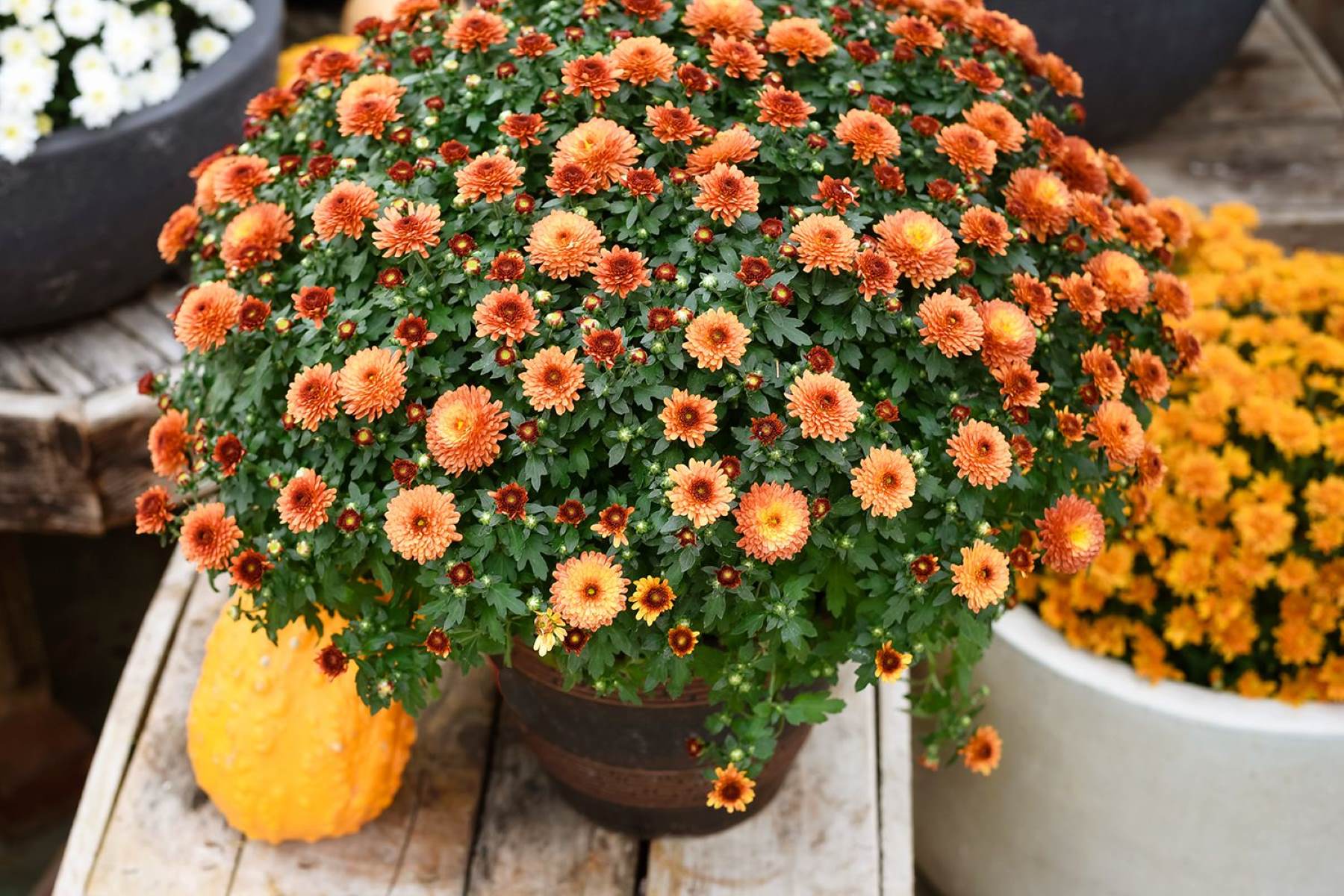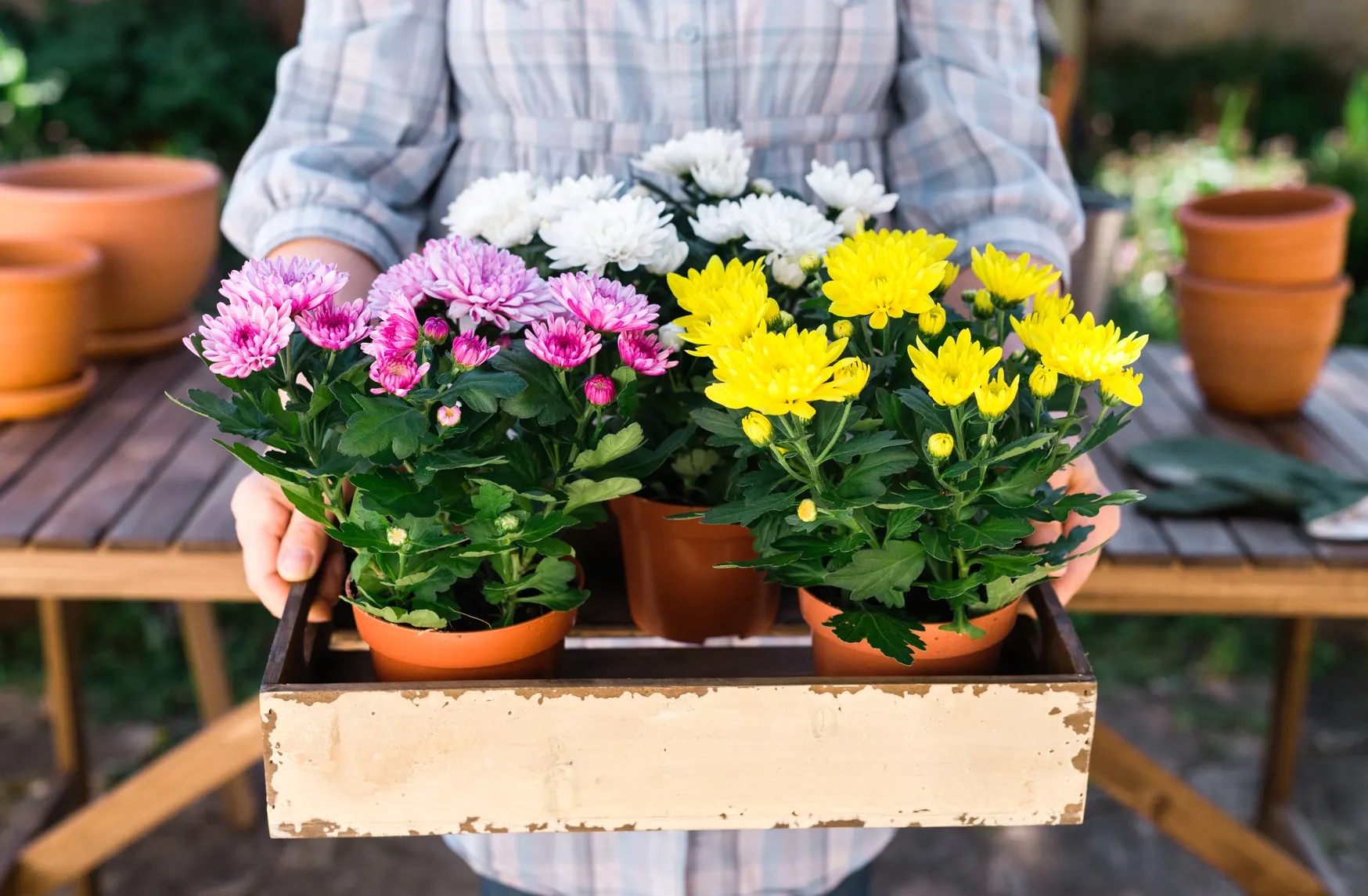Home>Gardening & Outdoor>Plant Care & Gardening Tips>How Do You Take Care Of Mums


Plant Care & Gardening Tips
How Do You Take Care Of Mums
Modified: October 20, 2024
Discover essential plant care and gardening tips for mums. Learn how to properly care for your mums and keep them thriving with expert advice and techniques.
(Many of the links in this article redirect to a specific reviewed product. Your purchase of these products through affiliate links helps to generate commission for Storables.com, at no extra cost. Learn more)
Introduction
Mums, also known as chrysanthemums, are vibrant and versatile flowering plants that have become a beloved staple in gardens and floral arrangements. With their stunning array of colors and unique petal formations, mums add a touch of elegance and charm to any outdoor space. Whether you're a seasoned gardener or a novice plant enthusiast, caring for mums can be a rewarding and enjoyable experience.
These resilient perennials are native to Asia and northeastern Europe, and they have been cultivated for centuries, resulting in a wide variety of shapes, sizes, and colors. From the classic daisy-like blooms to the intricate pompom and spider mum varieties, there is a chrysanthemum to suit every taste and preference.
Mums are often associated with autumn, as they bloom profusely during this season, adding a burst of color to gardens and landscapes. However, with the right care and attention, these beautiful flowers can thrive throughout the year, bringing joy and beauty to your outdoor spaces.
In this comprehensive guide, we will explore the essential aspects of caring for mums, from selecting the ideal location for planting to protecting them from pests and diseases. By understanding the specific needs of these delightful flowers, you can ensure that they flourish and continue to brighten your garden with their radiant blooms.
Whether you're a gardening enthusiast looking to expand your floral repertoire or a homeowner seeking to elevate your outdoor aesthetic, mastering the art of caring for mums will empower you to cultivate a stunning and vibrant garden that will be the envy of your neighborhood. So, let's delve into the world of mums and discover the secrets to nurturing these captivating flowers to their full potential.
Key Takeaways:
- Choose a sunny, well-drained spot and protect mums from wind and frost for vibrant blooms. Carefully balance watering and fertilizing to support their growth and vitality.
- Regular pruning, deadheading, and proactive pest and disease management are essential for maintaining the health and beauty of mums. Tailor overwintering strategies to protect them from harsh winter conditions.
Read more: When Do You Prune Mums
Choosing the Right Location
Selecting the optimal location for planting mums is crucial for their overall health and blooming success. These vibrant flowers thrive in areas that receive ample sunlight, typically requiring at least six hours of direct sunlight per day. When choosing a spot for your mums, prioritize locations with abundant sunlight exposure, such as south-facing areas in your garden or open spaces free from shading obstructions.
In addition to sunlight, it's essential to consider the soil quality and drainage in the chosen location. Mums prefer well-draining soil to prevent waterlogged conditions, which can lead to root rot and other moisture-related issues. Loamy soil with good drainage capabilities is ideal for mums, allowing excess water to flow away from the roots and preventing water accumulation that can harm the plants.
Furthermore, mums thrive in areas sheltered from strong winds, as excessive wind can damage their delicate blooms and stems. When selecting a location, consider the potential impact of prevailing winds and aim to position the plants in a relatively sheltered spot, such as near a fence or amidst other plants that can provide a natural windbreak.
It's important to note that mums are sensitive to temperature fluctuations, particularly during the winter months. To protect them from extreme cold, avoid planting them in low-lying areas where cold air may settle, increasing the risk of frost damage. Instead, opt for elevated locations that allow cold air to drain away, reducing the likelihood of frost affecting the plants.
In summary, when choosing the right location for your mums, prioritize areas with ample sunlight exposure, well-draining soil, and protection from strong winds. By carefully considering these factors, you can create an optimal environment for your mums to thrive, ensuring that they produce an abundance of vibrant blooms and enhance the beauty of your garden throughout the growing season.
Watering and Fertilizing
Proper watering and fertilizing practices are essential for nurturing healthy and vibrant mums throughout their growth cycle. Understanding the specific moisture and nutrient requirements of these resilient flowers is key to promoting robust growth and prolific blooming.
Watering
When it comes to watering mums, striking the right balance is crucial. These plants thrive in moist, well-drained soil, and maintaining consistent moisture levels is vital for their overall health. During the active growing season, which typically spans spring to early autumn, regular watering is essential, especially during dry spells or periods of intense heat.
To determine when to water your mums, perform a simple soil moisture test by inserting your finger into the soil near the base of the plants. If the soil feels dry to the touch, it's time to water. However, it's important to avoid overwatering, as excessive moisture can lead to root rot and other detrimental conditions. Aim to water the plants deeply, ensuring that the water reaches the root zone, but allow the soil to dry out slightly between watering sessions.
In contrast, during the winter months or when mums are in their dormant phase, reduce the frequency of watering to prevent waterlogging and potential cold damage. By adjusting your watering routine based on the seasonal needs of the mums, you can provide them with the ideal moisture levels to support their growth and vitality.
Fertilizing
In addition to proper watering, fertilizing mums is essential for supplying them with the necessary nutrients to thrive and produce abundant blooms. Before planting mums, incorporate a balanced, slow-release fertilizer into the soil to provide a nutrient-rich foundation for the plants. This initial fertilization sets the stage for healthy growth and development as the mums establish themselves in their new environment.
During the active growing season, apply a water-soluble fertilizer formulated for flowering plants every two to three weeks to support continuous blooming and robust foliage. These fertilizers are specifically designed to provide mums with the essential nutrients, such as nitrogen, phosphorus, and potassium, which are vital for promoting strong stems, vibrant blooms, and overall plant vigor.
As the growing season transitions into late summer and early autumn, reduce the frequency of fertilization to avoid stimulating new growth that may be vulnerable to frost damage. By tapering off the fertilization as the mums prepare for dormancy, you can help them transition into a healthy and resilient state, ready to withstand the challenges of the upcoming winter.
By adhering to proper watering and fertilizing practices, you can provide your mums with the optimal growing conditions, ensuring that they thrive and dazzle with their radiant blooms. These fundamental care routines, when executed thoughtfully and consistently, contribute to the long-term health and beauty of your mums, allowing you to enjoy their stunning display year after year.
Read more: How Do You Keep Mums Alive
Pruning and Deadheading
Pruning and deadheading are essential tasks in the care regimen for mums, playing a pivotal role in maintaining their health, appearance, and blooming potential. By understanding the principles of pruning and deadheading, you can effectively enhance the vitality and visual appeal of your mums, ensuring that they continue to thrive and produce an abundance of vibrant blooms.
Pruning
Pruning mums is a fundamental practice that helps shape the plants, promote branching, and maintain their overall form. It involves the strategic removal of specific parts of the plant, such as spent blooms, leggy stems, and damaged foliage, to encourage healthy growth and prolific flowering. When the mums reach a height of around 6 to 8 inches in the early spring, it's advisable to pinch back the growing tips, which stimulates lateral branching and results in bushier, more compact plants. This initial pruning sets the stage for a robust and well-structured growth habit, laying the foundation for a profusion of blooms later in the season.
Throughout the growing season, regular pruning of mums is beneficial for maintaining their shape and preventing them from becoming overly leggy or unruly. By removing faded or withered blooms, you can redirect the plant's energy towards producing new flowers, prolonging the blooming period and enhancing the overall visual impact of the display. Additionally, the removal of yellowing or diseased foliage through selective pruning helps maintain the plant's health and prevents the spread of potential diseases, contributing to a vibrant and vigorous appearance.
Deadheading
Deadheading, the practice of removing spent blooms from the mums, is a simple yet effective technique that promotes continuous flowering and prevents the formation of seeds. By snipping off faded flowers as soon as they begin to decline, you can stimulate the production of new buds and extend the blooming period, resulting in a more abundant and prolonged display of colorful blooms. This process not only enhances the aesthetic appeal of the plants but also encourages them to allocate their resources towards generating fresh blooms, rather than expending energy on seed production.
Regular deadheading also contributes to the overall neatness and tidiness of the mums, preventing the formation of unsightly seed heads and maintaining a clean and polished appearance. As the season progresses, diligent deadheading ensures that the plants remain vibrant and visually appealing, creating a captivating focal point in your garden or landscape.
In summary, the combined practice of pruning and deadheading is instrumental in shaping the growth, prolonging the blooming period, and preserving the health and beauty of mums. By incorporating these essential tasks into your care routine, you can cultivate robust, well-structured plants that continuously dazzle with their radiant blooms, elevating the allure of your outdoor spaces.
Protecting from Pests and Diseases
Protecting mums from pests and diseases is crucial for maintaining their health and ensuring a vibrant and thriving garden display. These resilient flowers, while generally resistant to many common garden pests and diseases, can still be susceptible to certain issues that may compromise their growth and overall vitality. By implementing proactive measures and vigilant monitoring, you can safeguard your mums from potential threats, allowing them to flourish and adorn your outdoor spaces with their stunning blooms.
Read more: What Do You Cover Mums With For Frost
Pest Prevention
One of the primary pests that can affect mums is the notorious aphid. These tiny, sap-sucking insects can quickly multiply and infest the tender new growth of mums, causing damage to the foliage and buds. To deter aphids, regularly inspect the plants for any signs of infestation, such as distorted leaves or sticky honeydew residue. If aphids are detected, gently spraying the affected areas with a strong jet of water can help dislodge and remove the pests. Additionally, introducing natural predators, such as ladybugs or lacewings, can serve as an effective biological control method to manage aphid populations and maintain a healthy balance in the garden.
Another common pest that mums may encounter is the spider mite, particularly in hot and dry conditions. These minuscule arachnids can cause stippling and discoloration of the leaves, leading to a weakened appearance in the plants. To prevent spider mite infestations, ensure adequate moisture levels around the mums by regular watering and maintaining a humid environment. In cases of severe infestation, applying a targeted insecticidal soap or horticultural oil can help mitigate the spider mite population without harming beneficial insects.
Disease Management
While mums are generally resilient to diseases, they can be susceptible to fungal issues, such as powdery mildew and gray mold, especially in humid or overcrowded growing conditions. To prevent fungal diseases, provide ample air circulation around the plants by spacing them appropriately and avoiding overhead watering, which can create favorable conditions for fungal growth. If signs of powdery mildew or gray mold appear, promptly remove and dispose of affected plant parts to prevent the spread of the disease, and consider applying a fungicidal treatment to mitigate further development.
Furthermore, maintaining overall plant health through proper watering, fertilization, and pruning practices is essential for bolstering the mums' natural defenses against diseases. By promoting strong and vigorous growth, you can reduce the susceptibility of the plants to fungal and bacterial infections, ensuring that they remain robust and resilient in the face of potential disease challenges.
By implementing these proactive measures and staying vigilant in monitoring the health of your mums, you can effectively protect them from pests and diseases, allowing these captivating flowers to thrive and grace your garden with their resplendent beauty. With a proactive and attentive approach, you can cultivate a healthy and vibrant environment for your mums, ensuring that they continue to enchant and inspire with their radiant blooms.
Overwintering
Overwintering mums is a critical aspect of their care, particularly in regions where winter temperatures can be harsh and unforgiving. As the growing season transitions into the colder months, it's essential to prepare your mums for the challenges of winter, ensuring that they survive the cold and emerge strong and vibrant when spring arrives.
The first step in overwintering mums is to assess the specific climate and environmental conditions in your region. Understanding the typical winter temperatures, frost dates, and potential weather extremes allows you to make informed decisions regarding the best approach to protect your mums during the colder months. By being aware of the local climate patterns, you can tailor your overwintering strategies to suit the specific needs of your mums and mitigate the potential risks associated with winter weather.
In regions where winter temperatures plummet below freezing, providing adequate insulation and protection for mums is crucial. Applying a thick layer of organic mulch, such as straw or shredded leaves, around the base of the plants helps insulate the roots and maintain more stable soil temperatures. This protective mulch layer acts as a buffer against extreme cold, reducing the risk of root damage and enhancing the mums' ability to withstand winter conditions.
In addition to mulching, consider providing physical protection for the above-ground portions of the mums. Erecting a simple frame around the plants and covering them with breathable fabric or burlap can shield them from harsh winds and extreme temperature fluctuations. This protective covering helps create a microclimate around the mums, minimizing the impact of freezing temperatures and reducing the risk of frost damage to the tender foliage and stems.
For potted mums, overwintering may involve relocating the containers to a sheltered area, such as a garage or shed, where they can be shielded from the harshest winter conditions. Ensuring that the potted mums receive adequate but reduced watering during the dormant period is essential, as excessive moisture in the soil can lead to root rot in the confined space of the containers.
In regions with milder winter climates, where freezing temperatures are less frequent, mums may require less intensive overwintering measures. However, it's still advisable to monitor the moisture levels in the soil and provide occasional protection from extreme cold snaps to safeguard the plants and promote their resilience.
By implementing thoughtful overwintering practices tailored to the specific needs of your mums and the prevailing winter conditions, you can ensure that these resilient flowers emerge from the dormant period ready to thrive and delight with their vibrant blooms when the warmth of spring returns. Overwintering mums is a proactive and essential aspect of their care, contributing to their long-term health and vitality, and setting the stage for another season of stunning floral displays in your garden.
Conclusion
In conclusion, caring for mums, or chrysanthemums, is a deeply rewarding endeavor that offers a myriad of benefits, from the joy of nurturing vibrant blooms to the enhancement of outdoor spaces with their captivating beauty. By delving into the intricacies of mums' care and understanding their specific needs, you can cultivate a thriving garden adorned with an abundance of radiant flowers.
The journey of caring for mums begins with selecting the right location for planting, ensuring that they receive ample sunlight, well-draining soil, and protection from harsh winds and extreme temperatures. By providing an optimal environment, you set the stage for the mums to flourish and grace your garden with their stunning array of colors and textures.
Watering and fertilizing mums are fundamental aspects of their care, requiring a delicate balance to maintain optimal moisture levels and provide essential nutrients for robust growth and prolific blooming. By adhering to thoughtful watering practices and strategic fertilization, you can support the mums' overall health and vitality, ensuring that they thrive throughout the growing season.
Pruning and deadheading play a crucial role in shaping the growth and appearance of mums, promoting bushy, well-structured plants and prolonging the blooming period. By incorporating these essential tasks into your care routine, you can cultivate mums that continuously dazzle with their radiant blooms, creating a captivating focal point in your garden or landscape.
Furthermore, protecting mums from pests and diseases is vital for maintaining their health and visual appeal. By implementing proactive measures and staying vigilant in monitoring the plants, you can safeguard them from potential threats, allowing these captivating flowers to thrive and enchant with their resplendent beauty.
Overwintering mums is a proactive and essential aspect of their care, ensuring that they survive the challenges of winter and emerge strong and vibrant when spring arrives. By tailoring overwintering strategies to suit the specific needs of your mums and the prevailing winter conditions, you can set the stage for another season of stunning floral displays in your garden.
In essence, caring for mums is a journey that encompasses nurturing, creativity, and a deep appreciation for the natural beauty of these resilient flowers. By embracing the art of mums' care, you can cultivate a vibrant and enchanting garden that serves as a testament to your dedication and passion for plant cultivation. With each season, the mums will continue to flourish, bringing a sense of wonder and delight to your outdoor spaces, and leaving a lasting impression on all who behold their radiant splendor.
Frequently Asked Questions about How Do You Take Care Of Mums
Was this page helpful?
At Storables.com, we guarantee accurate and reliable information. Our content, validated by Expert Board Contributors, is crafted following stringent Editorial Policies. We're committed to providing you with well-researched, expert-backed insights for all your informational needs.














0 thoughts on “How Do You Take Care Of Mums”